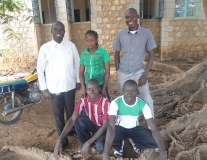- About
- Topics
- Picks
- Audio
- Story
- In-Depth
- Opinion
- News
- Donate
- Signup for our newsletterOur Editors' Best Picks.Send
Read, Debate: Engage.
| December 18, 2017 | |
|---|---|
| topic: | Refugees and Asylum |
| tags: | #Africa, #migration, #agriculture, #South Sudan, #refugees |
| located: | South Sudan |
| by: | Israel Bionyi |
“Land has been central to statehood in Sudan and a major contributor to conflicts and instability,” said Peter Hakim Justin and Han van Dijk in a recent publication analysing land reforms and conflict in South Sudan. According to them, the land did not only spur the split of Sudan but it also continues to dangerously divide the newly formed South Sudan, causing untold suffering, record conflicts, civil wars, and forceful displacements.
On 28 November 2017, as families over the globe enjoyed a peaceful night, people in Eastern South Sudan witnessed a gruesome attack. At least 50 victims, 19 men and 23 women were cold-bloodedly slaughtered.
The official statement on the matter says armed men from the Murle ethnic group targeted Dinkas living in villages around 150 kilometres north of Bor, in Jonglei state, South Sudan.
But what hides behind this recent attack, not often reported in mainstream media is a ginormous land crisis that has been tearing the young nation to shreds for over a decade.
The land belongs to the people
During the secession wars with Sudan, fighters were told, “the land belongs to the community” and “towns to the people”. Unfortunately, transitioning to independence, the value of land and resources soared and the establishment reinforced its grip on land, creating new violent circles of tension.
“My only regret is that what we were fighting for, we did not have it,” says Mama Garang, 50, a former soldier of the liberation movement.
“The Sudan People's Liberation Movement (SPLM) had a policy that the people that owned the land, should have the right to keep the land and to continue to use the land [before independence]. When they took over power, they changed that policy and made it even worse than what was there before,” said Mr Halle Jorn Hanssen, 80, during the launch of his book “Lives at stake” at the Safari Club Hotel in Nairobi, Kenya on November 8 2017. Mr Hanssen worked in South Sudan for over 20 years and his publication details the South Sudan Liberation Struggles.
Leasing community lands to large-scale investors
Gradually, legislation after legislation, the establishment changed the rules.
First, was the transition land legislation between 2005 and 2011 set by the comprehensive peace agreement body, which recognised ancestral tribal lands and empowered customary leaders as land custodians.
Second, came the 2013 reforms, which gave some clarity to land claims, identifying public, private and community lands. But before the community could understand that legislation, a presidential order came in force on October 2015, increasing the number of the states from 10 to 28,4 and on 14 January 2017, the number was raised to 32,5. This presidential act discriminately divided communities and further fuelled divisions and tribal conflicts threatening the country to date.
According to Mr Hanssen, what followed the act has been “leasing and selling of lands to foreign investors”. A search led by Joseph Jamus, a former Norwegian People’s Aid Researcher, found that between 2007-2010, roughly 25 million hectares of land in South Sudan were sold or leased to foreign financiers. Mr Hanssen found that in 2008, a US-based company, Nile Trading and Development Inc, entered into a deal with a local company based in Central Equatorial State, South Sudan for the lease of six million hectares of land, for $25 000. Such deals could inspire land grabbing, and tribal expansion, leading to such deadly attacks the world often wake up to.
Tired of the suffering
According to United Nations figures since the beginning of the conflict in South Sudan, 4 million people have fled the country, including 2 million internally displaced and spread across the country. Many of the displaced are facing difficult conditions. The World Health Organisation estimates “1.3 million people have fallen ill with malaria this year, while thousands are affected by cholera and measles – particularly along the Nile River and in camps for displaced people”.
Ayen Ring, 25 fled the conflicts to Kenya with her mother. Her father, could not make it, he died during the war. Ayen studies at the University of Nairobi and believes her future is back home. Just like Ayen, many young South Sudanese in refugee camps in Uganda, Congo and Kenya hope to return home because they are tired of their conditions.
“I think the future of the land in Sudan is bright, if handled by experts,” says Ayen with a lot of confidence. Her experience as a radio host in Kenya, has given her new hopes and aspirations.
“I want to be a farmer some day,” she says, but regrets the laws protecting the displaced people are ineffective and many people continue to lose their lands in conflicts.
“When your territory is attacked and you escape, attackers would definitely take over your land.”
But Mr Robert Lado, Chairperson of South Sudan Land Commission is confident to handle the forcefully displaced. Talking within the context of the Second Conference on Land Policy in Africa, organised by the African Land Policy Centre at the United Nations Economic Commission for Africa on November 16 2017, Mr Lado said: “Everybody knows their indigenous lands. Once those who left the country returns, the Land Commission will ensure a proper protection of their lands.”
By copying the embed code below, you agree to adhere to our republishing guidelines.
